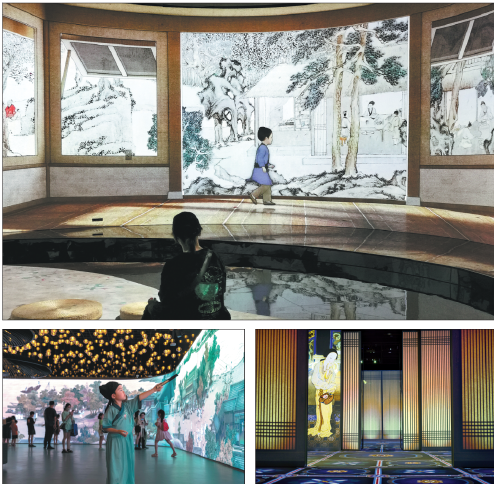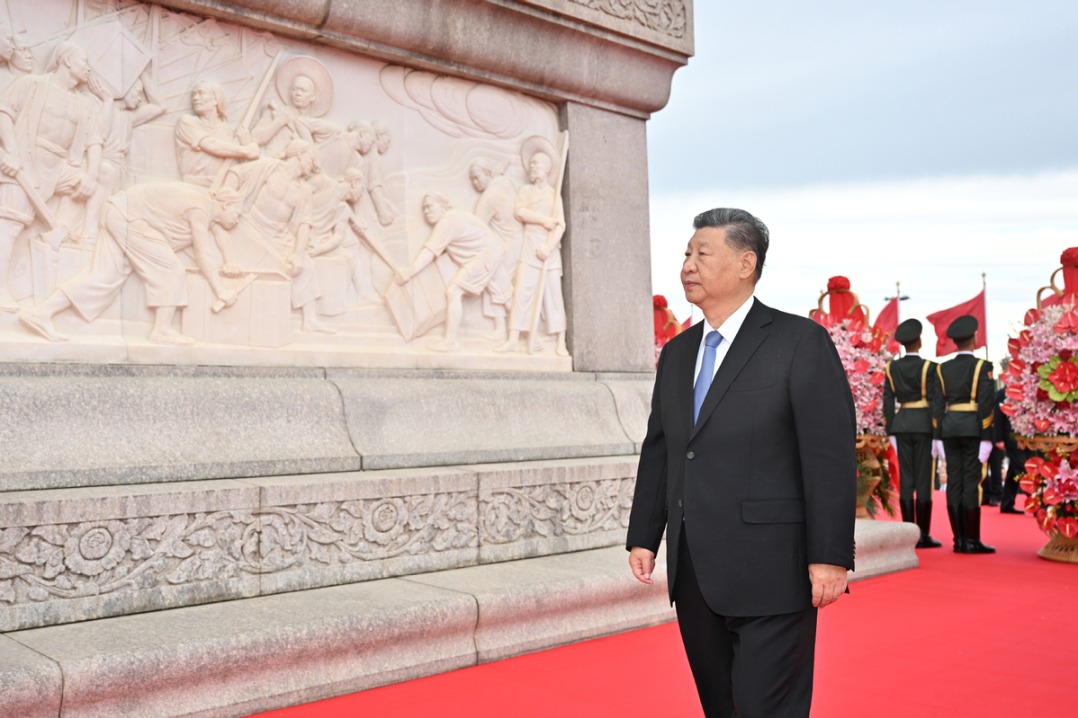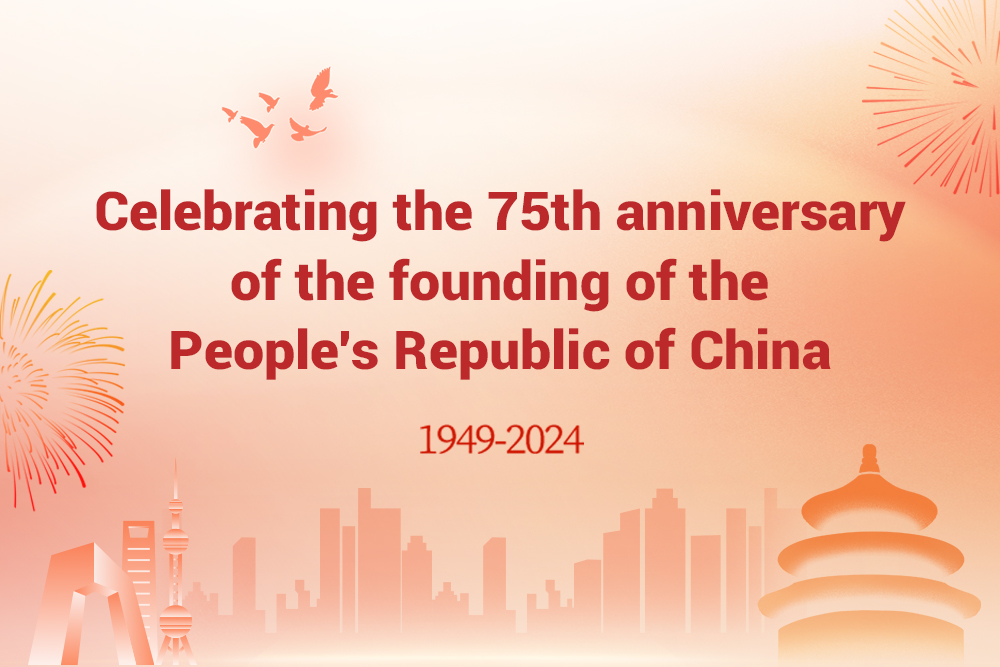Balancing between the virtual and actual
Museums around China are diving headfirst into harnessing the transformative power of new technology, Deng Zhangyu reports.

Equipped with a virtual reality headset and backpack, visitors are able to explore seven sacrificial pits at the Sanxingdui archaeological site up close. They can walk into them, crouch down to examine artifacts buried in the soil, follow archaeologists into the studio to watch the process of restoration, and even hold in their hands important items unearthed at the site, such as the famous gold mask.
In reality, this would be impossible at the site in Guanghan, Sichuan province. The seven sacrificial pits are carefully protected inside large, temperature- and humidity-controlled glass-walled rooms, and visitors can only watch archaeologists work from a distance.
This virtual exploration of the Sanxingdui archaeological site is the latest interactive experience from the Sanxingdui Museum, and marks an innovative step in the museum's digital transformation.
Since the beginning of August, the museum, one of the most popular in China, has been offering a trial version of the VR exploration of its newly excavated sacrificial pits, and since then, the 30-minute virtual experience has been enjoyed by a large number of visitors. Eager participants have had to wait in long lines every day.
Dong Jing, deputy director of the Sanxingdui Museum, says that the virtual exploration, which combines VR with archaeological data, provides users with a real and vivid interactive experience.
When Dong and her team took the program to the 10th Chinese Museums and Relevant Products and Technologies Exposition at the end of August in Hohhot, capital of the Inner Mongolia autonomous region, hundreds of visitors lined up to try it out.
The experience was offered in a special hall at the expo, where dozens of key museums gathered to demonstrate innovative high-tech programs offering immersive experiences. It became the most popular exhibition hall during the event.
This year, the theme of the expo focused on the digitalization of museums, and especially on ways to use digital technology to create immersive experiences. It included a forum on the topic of the integration of digital technology and displays.
Echoing the theme, the forum was moderated by two digital avatars, one of them being a digital staff member at Beijing's Capital Museum called Jing Hui. Her tasks at the museum include providing personalized artificial intelligence-guided tours to visitors.
In recent years, museums in China have been taking action to embrace digitalization. Using technology such as big data, virtual reality, augmented reality, and AI to enhance the visitor experience is inevitable, according to museum directors and experts at the forum.
"Offering visitors better service and attracting them to museums to gain a better understanding of the artifacts are our goals in employing digital technology," Dong says.
The deputy director adds that the Sanxingdui Museum opened a new branch last year, and set up a special exhibition hall for interactive programs. There, visitors can immerse themselves in the society of the ancient kingdom of Shu state, a prosperous Bronze Age civilization that dominated the upper Yangtze River region more than 3,000 years ago.
Since its opening last July, the new branch has received more than 5 million visitors. A new digital hall dedicated to a giant bronze tree unearthed at Sanxingdui is planned for next year.
In February, the Shanghai Museum opened a new branch, a two-story complex that is an expansion of its original downtown location. It has a digital hall on the second floor, roughly the size of a basketball court, which is dedicated to an immersive show, titled Poetic Jiangnan.
The 18-minute show takes visitors on a journey with a digital avatar of renowned Ming Dynasty (1368-1644) ink painter Dong Qichang, with whom they traverse 15 landscape paintings created by 12 master artists over a span of 1,000 years. All the paintings featured in the digital show are from the collection of the Shanghai Museum.
People can talk to Dong's digital avatar, interact with digital fish swimming on the floor, and watch digital petals falling into rivers. As the seasons change in the paintings, the background music also changes.
The hall opened to the public at the end of June and is so popular that appointments have to be booked two weeks in advance, according to Gong Yuwu, deputy director of the Shanghai Museum information center.
"These kinds of immersive shows will definitely be a future trend. They give people an easy and interesting way to appreciate art," Gong says.
After the show, people can view the paintings in the show in the other halls, a process of exploration that helps them understand the stories and culture behind the art.
Gong says that visitors, especially the young and parents with children, are often better versed in the subject, and so expect a more profound experience than simply looking at digital paintings.
"Digital technology is just a tool to help enhance the experience and attract more people to museums. The most advanced technology is not necessarily the best; what matters is what is most suitable for the presentation and experience of the exhibition," Gong says.
Poetic Jiangnan was coproduced by a Shanghai-based media company, Motion Magic. Zhou Mingzhe, a marketing manager of the company, says that the demand from museums to produce immersive shows has been rapidly increasing over the past two years and the company has already scheduled its collaborations with institutions across the country for next year.
All museums, from major to private, have worked hard to produce immersive experiences in recent years.
The Hunan Museum in Changsha, Hunan province, produced its first digital show The Art of Life: Multimedia Exhibition of Mawangdui Han Culture in June to highlight the archaeological discoveries at the Mawangdui Han Tombs, where 1,000 artifacts and a well-preserved female body dating back over 2 millennia were unearthed in 1972. Visitors are able to experience life as lived by their makers 2,000 years ago.
The Deji Art Museum in Nanjing, Jiangsu province, a small, private museum, digitalized An Era in Jinling, a historical painting by Feng Ning of the Qing Dynasty (1644-1911). It depicts vivid street scenes in Nanjing (called Jinling) of the Song Dynasty (960-1279). Visitors can interact with the 110-meter digital re-creation by wearing special electrical bracelets, and are able to set off fireworks in the painting, talk to vendors and a fortuneteller, and even play with cats and dogs.
With the implementation of the 144-hour visa-free policy this year, many foreign tourists have come to the museum to experience the digital exhibition, according to the museum's director Ai Lin.
The passion of museums for producing immersive digital shows can largely be attributed to the national drive toward the digital economy, in support of which many policies and guidelines have been issued in the past two years.
Last September, the Ministry of Industry and Information Technology and five other governmental bodies issued a Three-Year Action Plan for the Innovative Development of the Metaverse Industry (2023-25).The plan sets specific goals for various sectors, including museums, and strongly supports the wide application of metaverse technology, as a result of which, many museums now have digital employees.
In May, the Ministry of Culture and Tourism and several other ministries released the Action Plan for the Innovative Development of Smart Tourism. It outlined specific tasks for museums in terms of offering immersive, personalized experiences.
Li Qun, director of the National Cultural Heritage Administration, said at the August expo that museums have made great strides forward in digitalization. He also stressed on many occasions that digital technology should be vigorously promoted to offer better visitor experiences.
Since the Zhejiang Provincial Museum in Hangzhou first began offering Fair Ladies: Images of Ancient Women online in 2021, the exhibition has undergone several iterations with the development of digital technology. According to Cai Qin, deputy director of the Zhejiang Provincial Museum and curator of the exhibition, it's the "epitome of a museum's road to digitization in China".
In 2021, the COVID-19 pandemic meant that people had to stay at home for a long time, and so the Zhejiang Provincial Museum released an online exhibition of images of women in ancient paintings. It contained about 1,000 paintings from 32 museums, both within China and abroad, and permitted people to view the show without needing to leave their homes.
The following year, the exhibition was re-created in real time, and additional museums were brought in to participate. An exhibition hall was set up at the Zhejiang Provincial Museum, along with four additional spaces at the Jiangxi Provincial Museum, the Anhui Museum, the Suzhou Museum and the Huzhou Museum. Visitors to any of these five museums were able to view the halls at the other museums on screens placed at each location.
Last August, an immersive version of the exhibition opened at the Zhejiang Provincial Museum. It created an environment that allowed people to travel back in time to listen to women share their stories, and experience the eras in which they lived. The exhibition was divided into four sections, each employing different technology to offer a unique experience. It became popular with young people, and brought many women visitors to the museum.
"From online to offline, integrating physical exhibitions with virtual ones, the immersive shows now offered by many museums are the direction of future museum exhibitions," Cai says.
She believes that viewing art virtually does not offer a true experience, as it fails to convey the exact size, shape and material of the pieces displayed, and so paying a visit to an actual museum remains irreplaceable. However, by incorporating technology into exhibitions, people can have a deeper experience that allows them to break the boundaries of space and time.
"The integration of the physical and the virtual is an effective method for museums to spread their exhibitions' influence and enhance their services, and a single show can continue to improve with the development of technology."
The Fair Ladies series was upgraded this year to include images of modern women from around the world, and also introduced new forms of presentation, such as on-site performances and dramas.
"It seems that a show grows with us and with the upgrading of technology," Cai adds.


Today's Top News
- Washington urged to stop arming Taiwan
- Rapid growth seen in inbound tourism
- Big cities ease property sector restriction rules
- Friendship Award honors 100 expats' contributions
- Robust stock gains boost expectation of more moves
- Xi says China will safeguard world peace
Most Viewed
- Xi lays out priority tasks for urban development
- English majors face uncertain future as AI replaces basic skills
- Unit 731 atrocities a deep wound that can't be forgotten
- Turnaround in China-Australia ties benefits both
- US students explore Chinese culture and sustainability in Tianjin






























